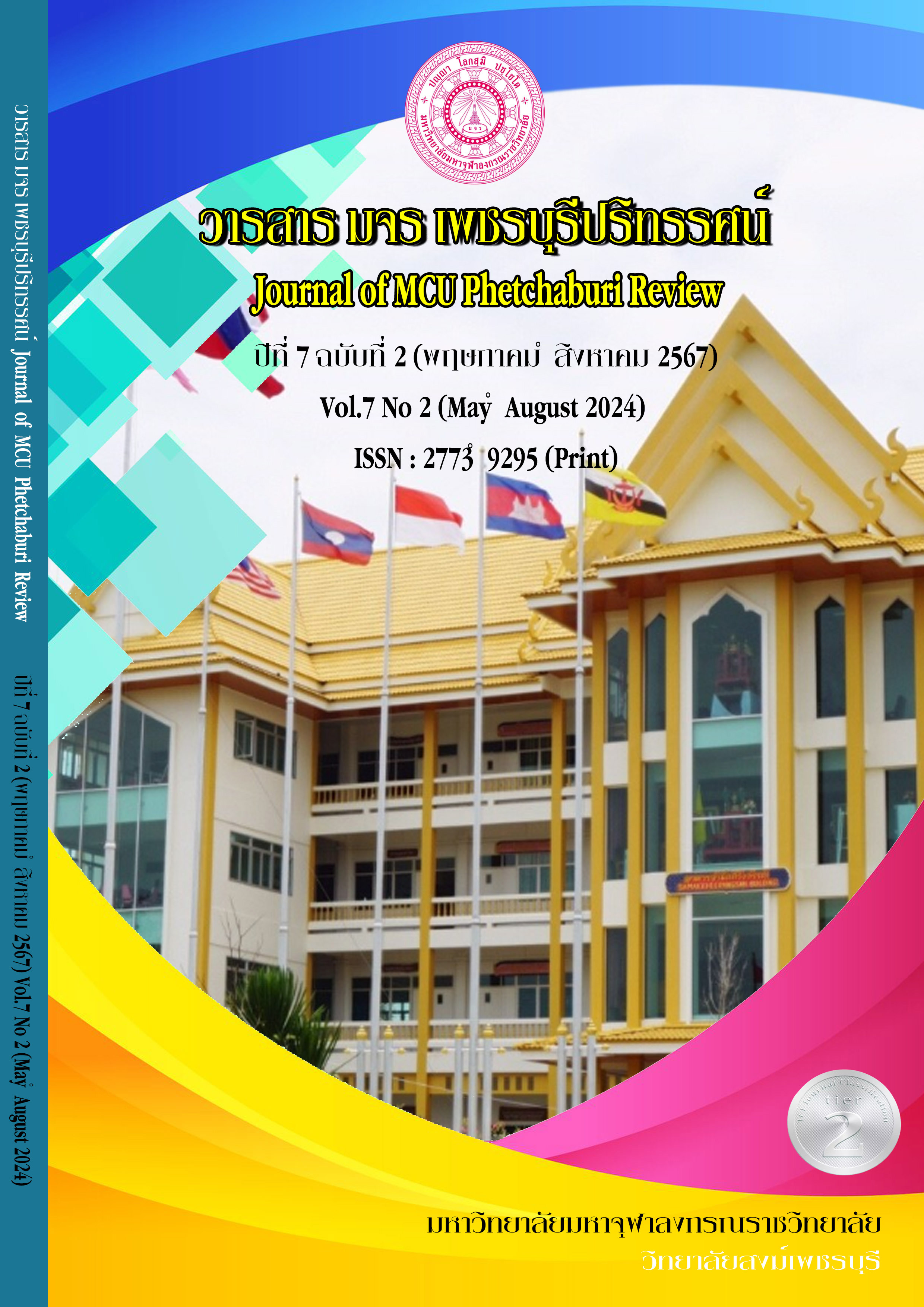โมเดลการวัดประสิทธิภาพโซ่อุปทานทางด้านสุขภาพ กรณีศึกษาจังหวัดเพชรบุรี
Main Article Content
บทคัดย่อ
การวิจัยนี้มีวัตถุประสงค์ 1) เพื่อศึกษาตัวชี้วัดประสิทธิภาพด้านสุขภาพ บูรณาการตามกรอบทฤษฎีห่วงโซ่อุปทาน จากตัวชี้วัดและมาตรฐานระดับสากล โดยใช้เทคนิคเดลฟายโดยใช้กลุ่มตัวอย่างคือผู้เชี่ยวชาญทางด้านการแพทย์ระดับชำนาญการจากทางภาครัฐ จำนวน 18 คน โดยใช้แบบสอบถามเป็นเครื่องมือในการเก็บข้อมูล ผลการศึกษา พบว่า ประกอบไปด้วย 4 มิติ 6 องค์ประกอบ 32 ตัวชี้วัด ได้แก่ มิติด้านปัจจัยนำเข้า ได้แก่ องค์ประกอบด้านทรัพยากรทางด้านการให้บริการสาธารณสุขที่ มิติด้านกระบวนการ ได้แก่ องค์ประกอบด้านการควบคุมโรคติดต่อ และองค์ประกอบด้านการควบคุมโรคไม่ติดต่อ (เรื้อรัง) มิติด้านการส่งมอบ ได้แก่ องค์ประกอบด้านมาตรฐานการให้บริการด้านสุขภาพ และองค์ประกอบด้านการส่งเสริมสุขภาพ มิติด้านสุขภาพของประชากร ได้แก่ องค์ประกอบด้านสถานการณ์ด้านสุขภาพ 2) เพื่อวัดประสิทธิภาพโซ่อุปทานทางด้านสุขภาพ กรณีศึกษาของจังหวัดเพชรบุรี พบว่า ทุกมิติของโซ่อุปทานและทุกองค์ประกอบยังไม่บรรลุเกณฑ์มาตรฐานที่องค์กรสากลกำหนดจำเป็นต้องปรับปรุงแต่ละองค์ประกอบให้มีประสิทธิภาพ บรรลุเกณฑ์มาตรฐานเพื่อยกระดับคุณภาพชีวิตความเป็นอยู่ของประชาชน เศรษฐกิจ และสังคมในอนาคตให้ดียิ่งขึ้น
Article Details

This work is licensed under a Creative Commons Attribution-NonCommercial-NoDerivatives 4.0 International License.
References
ดวงพรรณ กริชชาญชัย. (2566,) เปิดเส้นทางระบบยาและเวชภัณฑ์ไทยในห่วงโซ่อุปทานสุขภาพแห่งชาติ. เรียกใช้เมื่อ 23 สิงหาคม 2566 จาก M. Conference. MU SOCIAL ENGAGEMENT FORUM, mahidol.ac.th.
ธานินทร์ ศิลป์จารุ. (2563). การวิจัยและวิเคราะห์ข้อมูลทางสถิติด้วย SPSS และ AMOS. พิมพ์ครั้งที่ 18. กรุงเทพมหานคร : เอส. อาร์. พริ้นติ้ง แมสโปรดักส์
ปัญญา สำราญหันต์ และชิตพงษ์ อัยสานนท์. (2565). โมเดลการวัดประสิทธิภาพโซ่อุปทานด้านการดูแลสุขภาพด้วยเทคนิคของโมเดลสมการโครงสร้าง. วารสารปัญญาภิวัฒน์, 14(3), 106-120.
Garg K., Kumar C. N., & Chandra P. S. (2019). Number of psychiatrists in India: Baby steps forward, but a long way to go. Indian J Psychiatry, 61(1), 104-105.
An X, et al. (2022). Economic burden of public health care and hospitalisation associated with COVID-19 in China. Public Health, 203, 65-74.
Assembly, G. (2015). Sustainable development goals. SDGs transform our world, 2030(10.1186).
Brundtland, et al. (1987). Our common future: Oxford University Press, Oxford, GB.
Chan, M. (2018). Ten years in public health 2007-2017: report by dr margaret chan director-general world health organization: World Health Organization.
Chow, C. K., et al. (2018). Availability and affordability of essential medicines for diabetes across high-income, middle-income, and low-income countries: a prospective epidemiological study. The lancet Diabetes & endocrinology, 6(10), 798-808.
Cometto, G. et al. (2014). Health supply chain personnel: an integral part of the health workforce. In 7, 1-3.
Forehand, M. (2010). Bloom’s taxonomy. Emerging perspectives on learning, teaching, and technology, 41(4), 47-56.
Fukuda-Parr Sakiko. (2016). From the Millennium Development Goals to the Sustainable Development Goals: shifts in purpose, concept, and politics of global goal setting for development. Gender & Development, 24(1), 43-52.
Geist Monica R. (2010). Using the Delphi method to engage stakeholders: A comparison of two studies. Evaluation program planning, 33(2), 147-154.
Horner K, et al. (2009). Basic principles for use of dental cone beam computed tomography: consensus guidelines of the European Academy of Dental and Maxillofacial Radiology. Dentomaxillofacial Radiology, 38(4), 187-195.
Kendall Maurice G, & Smith B Babington. (1939). The problem of m rankings. The annals of mathematical statistics, 10(3), 275-287.
Likert, R. (1932). A technique for the measurement of attitudes. Archives of psychology.
Linstone Harold A, & Turoff Murray. (2011). Delphi: A brief look backward and forward. Technological forecasting social change, 78(9), 1712-1719.
Lugada, E. et al. (2022). Health supply chain system in Uganda: current issues, structure, performance, and implications for systems strengthening. Journal of Pharmaceutical Policy and Practice, 15(14), 1-11.
Musa Haruna Danladi, et al. (2015). Delphi Method of Developing Environmental Well-being Indicators for the Evaluation of Urban Sustainability in Malaysia. Procedia Environmental Sciences, 30, 244-249.
Okoli Chitu, & Pawlowski Suzanne. (2004). The Delphi method as a research tool: an example, design considerations and applications. Information management, 42(1), 15-29.
Prajapati Dimpy, et al. (2022). Impact of COVID-19 on Sustainability Enablers and Evaluation of Performance Index. Materials Today: Proceedings, 56, 3790-3796.
World Health Organization. (2016). Health workforce requirements for universal health coverage and the sustainable development goals. (human resources for health observer, 17).
World Health Organization. (2019). Hospital beds per 1,000 people. Retrieved March 7, 2024, from https://data.worldbank.org/indicator/SH.MED. BEDS.ZS

